What Are Chair Lift Parts? Quick Answers for Buyers
Chair lift parts are the individual components that keep a stair lift, porch lift, or lift chair working safely and smoothly. If your lift stops, makes unusual noises, or displays an error code, it usually means one of these parts needs repair or replacement.
Here's what you need to know right away:
| Common Chair Lift Parts | Typical Lifespan | Average Price Range |
|---|---|---|
| Batteries | 1–3 years | $30–$100 |
| Motor/Gearbox | 7–10 years | $300–$1,600 |
| Remote/Hand Control | 2–5 years | $55–$100 |
| Seat Cushions & Covers | 3–7 years | $50–$400 |
| Control Board | 5–10 years | $200–$900 |
| Rollers, Switches, Cables | 3–5 years | $5–$80 |
- You can buy chair lift parts as OEM (original), aftermarket, or refurbished online or through local dealers.
- Most leading brands like Stannah, Acorn, Handicare, Bruno, and Harmar have replacement parts available—even for older models.
- Fast shipping is possible: Many suppliers ship in under 8 business hours, with both new and used parts in stock.
"Our elevator repair Co couldn't find a replacement board for a year—this site had it in stock and shipped fast."
– Customer testimonial, Access2Parts
If you already know the brand and model of your lift, you can usually find the right part by checking the serial number and matching it with online listings or support staff.
I'm Mortuary Cooler, a national supplier of mortuary equipment and coolers, with years of expertise helping funeral professionals source reliable, cost-effective solutions—including chair lift parts for mortuary and mobility equipment.
Let's break down everything you need to know to keep your lifts running safely and efficiently.
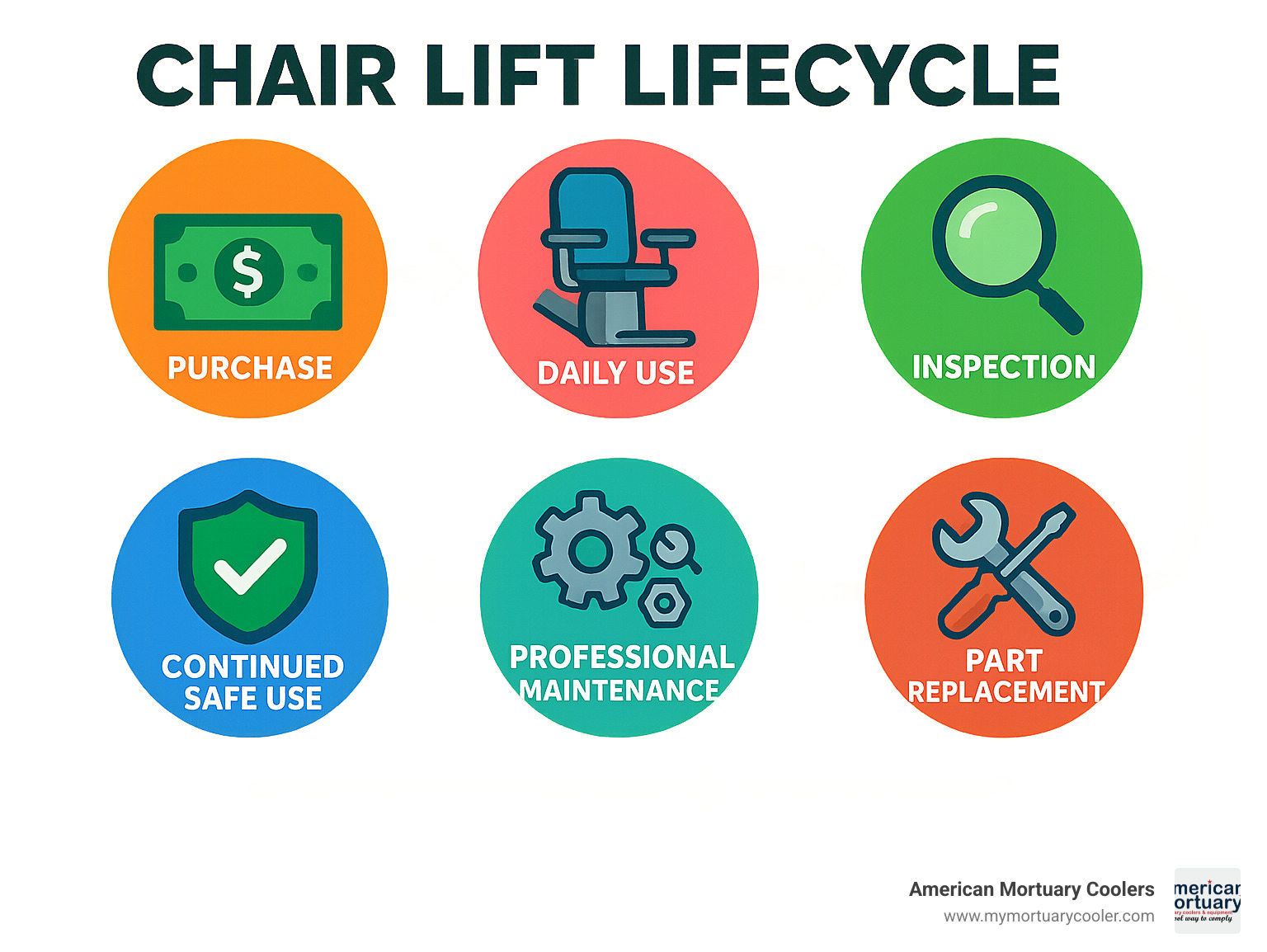
Understanding Chair Lifts: Types & How They Work
Let's chat about chair lifts before we dive into parts and repairs. Understanding what you're working with makes all the difference when something goes wrong and you need to find the right replacement part.
Types of Chair Lifts
Your mobility needs are unique, and thankfully, there's a chair lift designed for almost every situation.
The most common type you'll see in homes are stair lifts – those handy chairs that glide along a rail mounted to your staircase. If you have a straight staircase without any curves or landings, a straight stair lift is your friend. Got a more complicated staircase with turns, landings, or a spiral design? That's where curved stair lifts come in, custom-designed to steer those tricky corners.
For folks who use wheelchairs, porch lifts or vertical platform lifts are often the better choice. Instead of a chair, these lifts raise an entire platform, allowing wheelchair users to stay seated during the journey.
Then there are lift chairs – those cozy recliners that help you stand up and sit down with the press of a button. Perfect for those who need a gentle boost to get in and out of a seated position.
And yes, ski lifts are technically chair lifts too, though they operate quite differently from the mobility equipment we're focusing on!
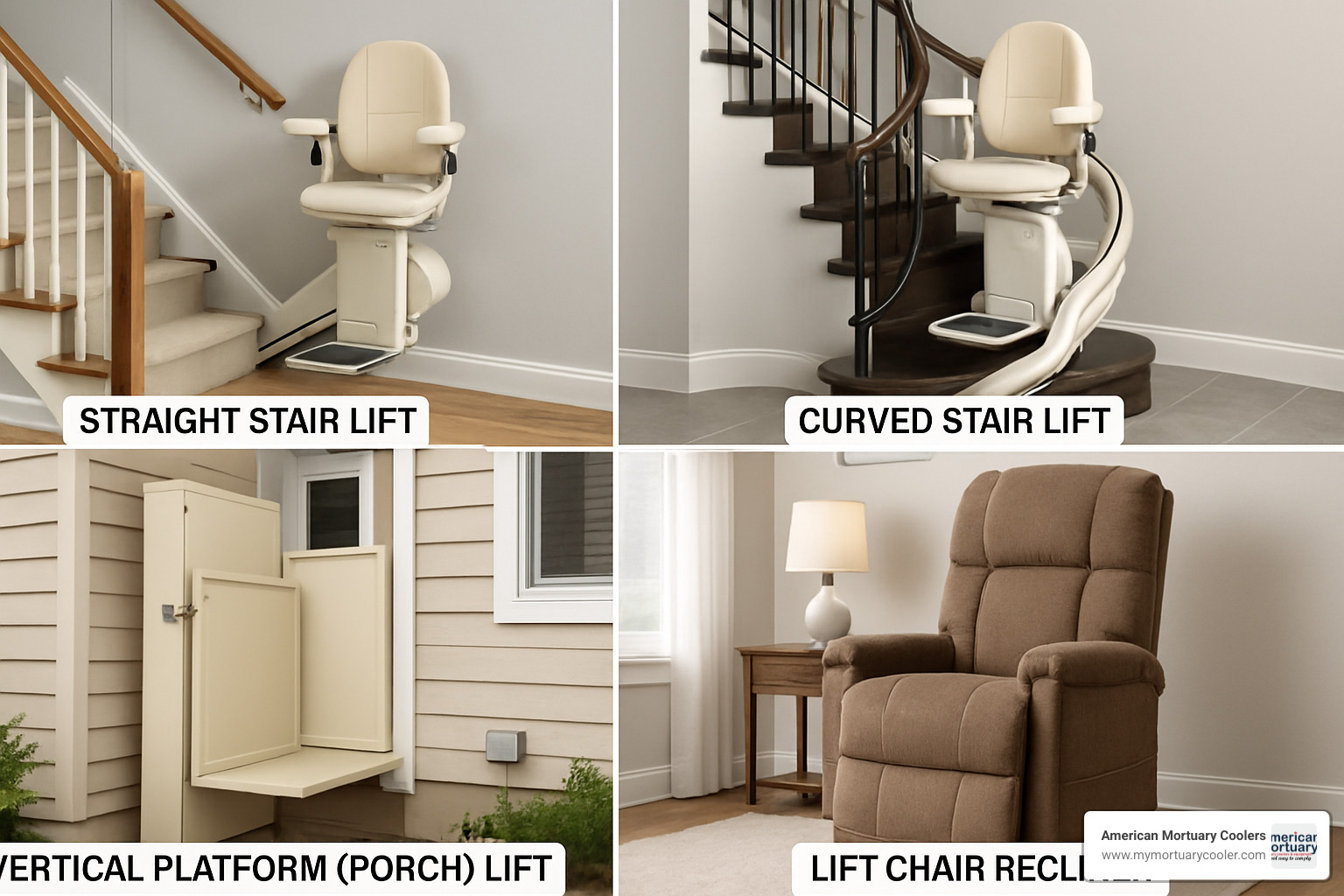
Why So Many Lift Types Exist
You might wonder why there are so many different chair lift options. It's all about meeting diverse needs:
Your home's architectural barriers play a big role – every house has unique staircases, doorway widths, and space limitations that require different solutions.
Your mobility level matters too. Some folks can transfer to a seat without much trouble, while others need their wheelchair to come along for the ride.
Environment is another factor. Indoor lifts stay protected from the elements, while outdoor lifts need serious weatherproofing to stand up to rain, snow, and temperature changes.
As Noah Nichols, Parts and Customer Service Manager at Skytrac, wisely points out: "The specific environment and user needs dictate the type of lift and components required for reliable operation."
Basic Operating Principles
Despite their differences, most chair lift parts work together in similar ways:
At the heart of every lift is the drive system – typically either a rack-and-pinion setup (where a motor with gears engages with a toothed track) or a cable drum system (where a motor winds or unwinds a cable to move the chair).
Power-wise, you'll find either AC-powered lifts that plug directly into your home's electrical system, or DC-powered models that use batteries that recharge when the lift isn't in use. Those battery-powered models are particularly nice during power outages!
The core components include the motor and gearbox that provide the power, the carriage (the chassis holding the chair that travels along the track), the track/rail itself, the control system (circuit boards managing operations), and the user interface (hand controls, call/send stations, and safety switches).
Understanding these basics helps tremendously when you need to order replacement chair lift parts or explain what's happening to a repair technician. It's like knowing the difference between a carburetor and a fuel injector when your car breaks down – not essential, but incredibly helpful!
The Anatomy of a Chair Lift: Key Parts That Wear Out
Like any mechanical system with moving parts, chair lifts naturally experience wear and tear over time. Understanding which components typically need replacement helps you stay ahead of maintenance issues and keeps your lift running safely and smoothly.
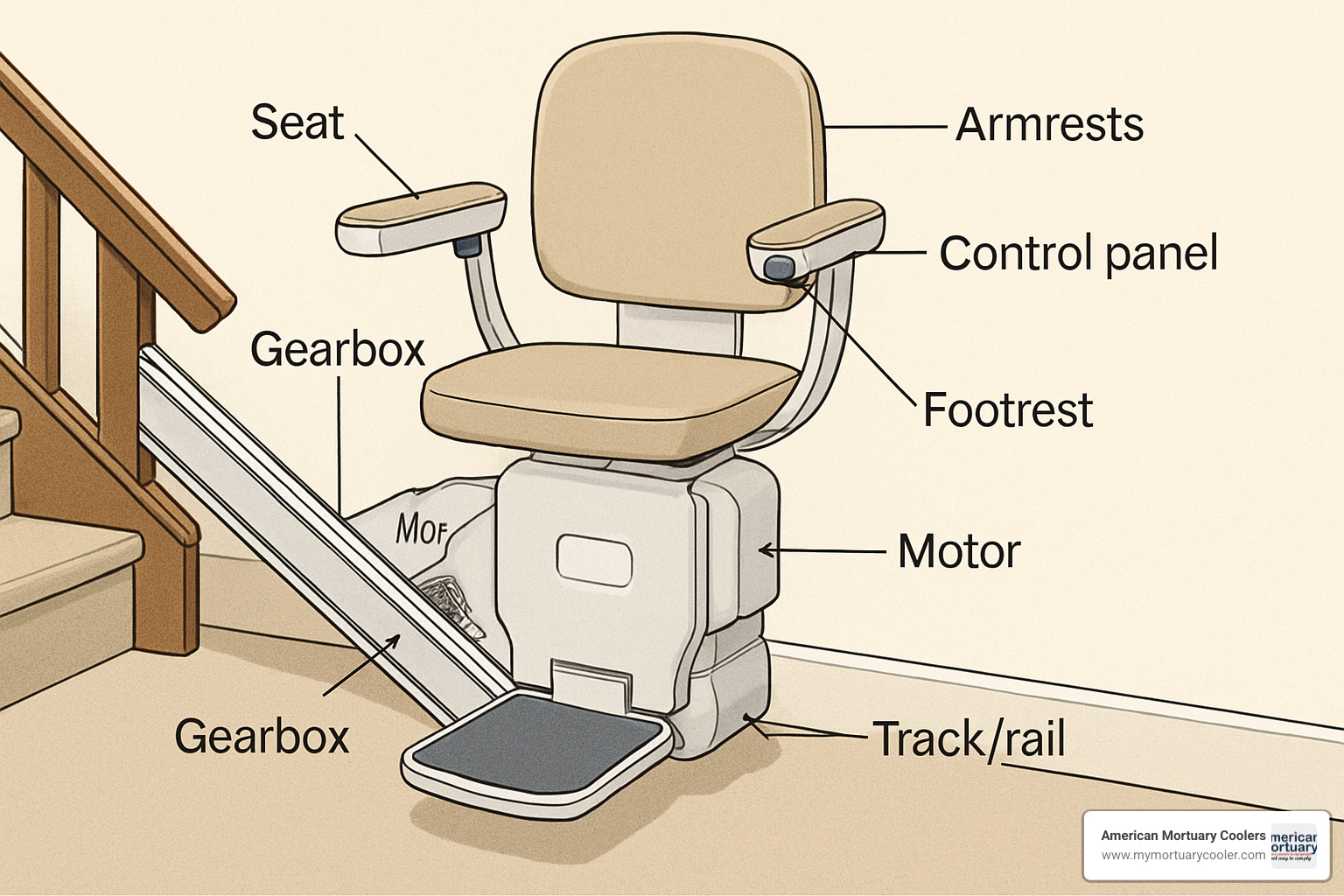
Common Chair Lift Parts Needing Replacement
Your chair lift is a symphony of components working together, but certain parts tend to wear out faster than others.
Those batteries are typically the first to go, usually lasting just 1-3 years before needing replacement. If your lift starts moving more slowly or doesn't complete as many trips between charges, it's likely time for new batteries. Most DC-powered lifts use 12V or 24V rechargeable batteries that cost between $30-$100 depending on your model.
The rollers that guide your chair along the track typically last 3-5 years of regular use. You'll know they're wearing out when your once-quiet lift starts making concerning squeaks, vibrations, or gives you a bumpy ride. Replacement rollers run about $5-$30 each, though they're often sold in complete sets for convenience.
Have you noticed your hand controls or remotes becoming finicky? After 2-5 years of being dropped, handled with food residue, or just general use, these crucial interface components often develop unreliable connections or button failures. A replacement typically costs $55-$100 – a small price to pay for restored convenience.
The heart of your lift system, the motor and gearbox, typically provides 7-10 years of reliable service before problems develop. When you hear grinding noises or experience jerky operation, it's often a sign these components need attention. This is one of the pricier replacements at $300-$1,600, depending on your lift's make and model.
As one relieved customer told Access2Parts: "After years of searching for a replacement control board, we finally found it here. Our elevator is running again after a year of being out of service." These control boards – the electronic brains of your lift – typically last 5-10 years before power surges, moisture, or component aging take their toll. Expect to pay $200-$900 for a replacement.
Other parts to watch include seat components (cushions, upholstery, swivel mechanisms) that naturally wear from daily use, and trailing cables that can fray over time as they flex with each journey up and down the stairs.
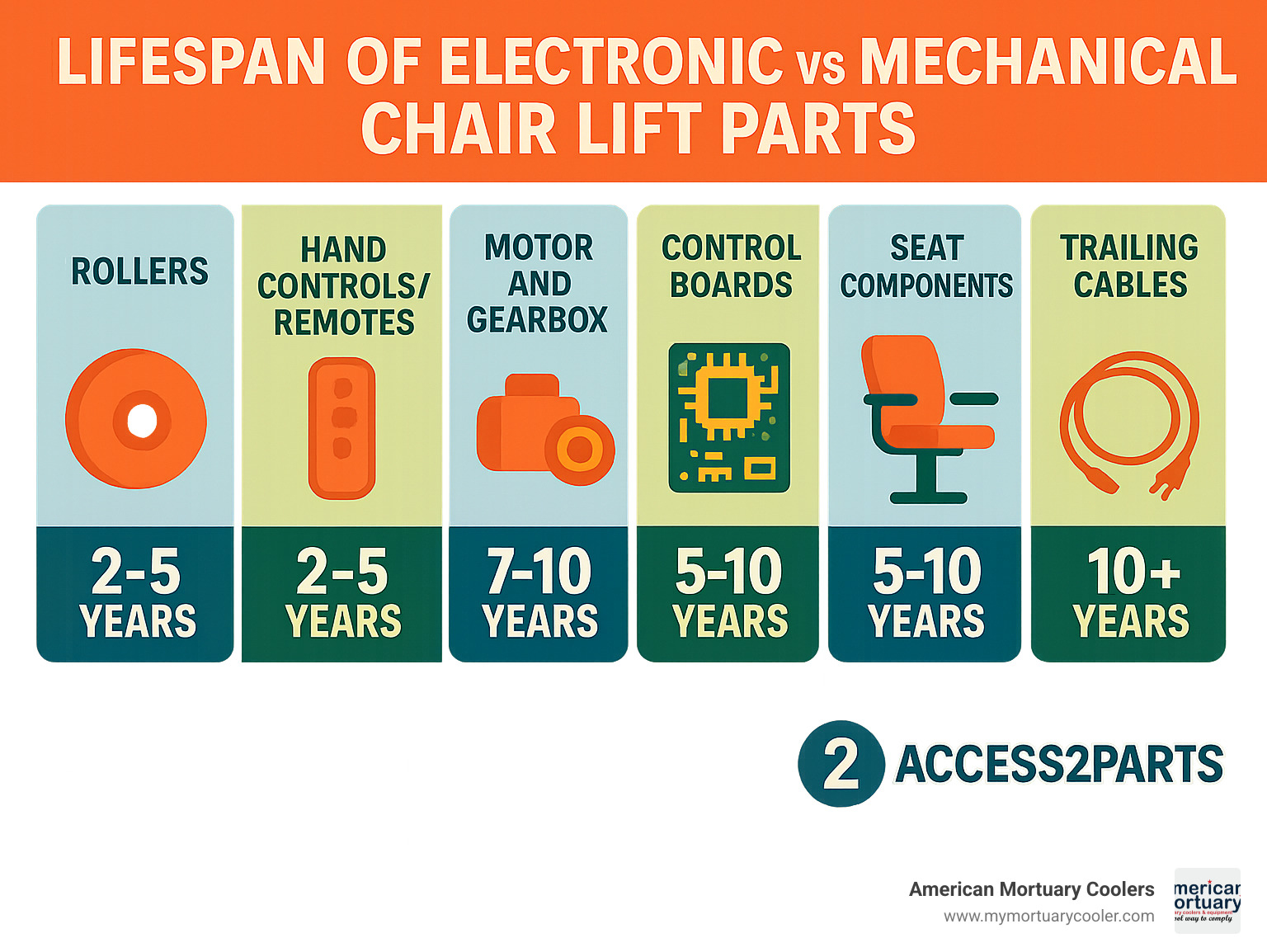
Chair Lift Parts & Safety Interlocks
The safety systems in your chair lift should never be compromised or bypassed – even temporarily. These critical chair lift parts quite literally keep you or your loved ones from harm.
The overspeed governor acts like a vigilant guardian, constantly monitoring your lift's speed. If mechanical failure causes the lift to move too quickly, this system automatically engages the brakes. Because of its crucial role, a faulty overspeed governor typically requires professional replacement.
Your lift's limit switches define the safe operating boundaries, preventing the chair from traveling beyond safe endpoints. If your lift mysteriously stops before reaching its destination, these switches may need adjustment or replacement.
Those pressure-sensitive safety edges are the lift's "sense of touch," immediately stopping operation if they detect an obstacle in the path. These sensors can wear out over time and should be promptly replaced if they become damaged or unresponsive.
Don't overlook the humble seat belt and harness systems – these simple yet critical components prevent falls and require regular inspection. At the first sign of fraying, stiffness, or buckle problems, replacement is essential rather than optional.
Lastly, those emergency stop buttons provide immediate shutdown capability in case of trouble. They should always function flawlessly, regardless of the lift's overall condition.
At American Mortuary Coolers, we understand that mobility equipment reliability isn't just about convenience – it's about safety and independence. When safety components show signs of wear, immediate replacement with proper chair lift parts is never something to postpone. After all, the best lift is one you can trust without a second thought.
Sourcing Chair Lift Parts: OEM vs Aftermarket vs Refurbished
When your chair lift needs a new part, knowing where—and what—to buy matters. The world of chair lift parts can feel a bit like shopping for car parts: do you stick with the original, try a third-party, or go with something gently used? Let’s break down your choices so you can make the best call for your lift, your wallet, and your peace of mind.
OEM (Original Equipment Manufacturer) Parts
These are the official parts made or authorized by your lift’s original maker. Picture them as the “factory originals.” With OEM parts, compatibility and fit are guaranteed—they are built for your chair lift’s make and model, right down to the last bolt.
They’re also often made with top-notch materials, which means they tend to last longer and keep your lift running smoothly. If your lift is still under warranty, using OEM parts is sometimes required to keep that coverage intact.
But, as with many things in life, you get what you pay for. OEM chair lift parts are usually the most expensive option. For rare or older models, you might also have to wait a bit longer, or in frustrating cases, find the part has been discontinued.
Aftermarket Parts
Think of aftermarket parts as the “off-brand” option—but don’t let that scare you off. These are made by other companies, not your lift’s manufacturer, but are designed to fit and function just like the originals.
Aftermarket chair lift parts can save you a good chunk of change. They’re also often in stock and ship quickly for those urgent fixes. Sometimes, aftermarket parts even come with small improvements over the originals (think better materials or updated designs).
However, quality can vary. It pays to buy from a reputable supplier. If your lift is still under warranty, double-check whether aftermarket parts are allowed—they could void your coverage. And, very occasionally, you might need to do a little tweaking or adjusting to get the perfect fit.
Refurbished/Used Parts
On a tight budget? Or maybe you’re searching for a part for a discontinued lift? Refurbished or used chair lift parts can be a real lifesaver. These parts have had a previous life, but they’re cleaned, tested, and restored to working condition before they’re resold.
They’re almost always the most budget-friendly solution, and they’re the eco-friendly choice as well. Sometimes, they’re the only way to keep an older lift going.
There are a few trade-offs, of course. Refurbished parts may not last as long as brand-new ones, and warranties (if any) are limited. Give used parts a close inspection for hidden wear or damage—if you’re unsure, ask the supplier about their testing process. For example, the folks at Stairlift-parts.com carefully clean and check every part before sending it out, so you know what you’re getting.
Where to Buy Chair Lift Parts
You have a few main routes when it comes to buying chair lift parts:
Manufacturer Direct: If you want OEM parts and the peace of mind that comes with them, buying directly from your lift’s maker (or their authorized dealers) is often best. Brands like Bruno, Harmar, Stannah, and Handicare all support their products this way. Sometimes, you’ll need to go through a local dealer to place your order.
Specialized Online Warehouses: These sites are a treasure trove, offering a wide variety of new, used, and even hard-to-find parts for many brands. Good examples include Access2Parts, Stairlift-parts.com, and A1 Stairlift Spares. If you have an older or rare lift, chances are you’ll find what you need here.
Local Mobility Equipment Dealers: There’s real value in talking to someone face-to-face. Local shops can help you identify the right part, offer advice, and sometimes even install it for you. They usually stock the most common replacement chair lift parts.
General Online Retailers: These can be a good source for standard parts like batteries or remotes, but beware—specialized or brand-specific parts might not be available, and customer support is often limited.
For general guidance on safely recycling old batteries when you do replace them, see the U.S. Environmental Protection Agency’s battery disposal tips at https://www.epa.gov/recycle/used-household-batteries.
If you’re in Tennessee, Georgia, or anywhere in the continental U.S., American Mortuary Coolers is always ready to help funeral homes and medical facilities source the right chair lift parts for their specific equipment. Our team knows how critical reliability is—and we’re just a call or click away.
Shipping, Payment & Returns
Ordering chair lift parts shouldn’t be a hassle. Most specialized suppliers offer fast shipping, often packing and sending your order within eight business hours. You’ll get tracking info (so you can watch your package cross the country, if that’s your thing), and international shipping is available from many suppliers—though customs can add a few days.
Paying is usually straightforward: major credit cards, PayPal, and even ApplePay are accepted at most places. If you’re ordering for a business, purchase orders or financing options may be available, especially for larger needs like full lift systems.
Returns and warranties are important to check before you buy. Most suppliers give you 30 days to return incorrect or defective parts, but keep an eye out for restocking fees (typically 15–25%). If your part has a core return (where you send back your old part for a discount or rebate), be sure to follow their instructions. Some sellers—like LiftChairExperts—offer extra peace of mind with a 12-month “No Hassle Warranty” on replacement parts.
Choosing the right chair lift parts isn’t just about what fits—it’s about balancing cost, quality, and turnaround time. And remember, if you ever need help, American Mortuary Coolers is happy to point you in the right direction.
Finding the Right Chair Lift Parts: Identification & Ordering
Finding the exact part your chair lift needs shouldn't feel like solving a mystery. With a little detective work and the right resources, you can identify and order the correct chair lift parts with confidence.
Locate Your Model Information
The first step is gathering your lift's vital statistics. Think of it as creating your lift's ID card.
Look for the serial number and model tag, which are usually hiding on the underside of the chair or somewhere on the motor housing. If you can't find them there, check your owner's manual or original paperwork. These numbers typically follow a format like "SRE-3000 / SN: 123456789" – this is your golden ticket to finding the right parts.
The manufacture date matters too, since manufacturers sometimes change designs between production runs. This date is often on the model tag, though some companies use date codes instead of calendar dates.
When it comes to identifying the specific part that's failed, your owner's manual is your best friend. Those parts diagrams might look complicated at first glance, but they're incredibly helpful for pinpointing exactly what you need. Take clear photos of the broken component from multiple angles, and make note of any part numbers or identifying marks you can see.
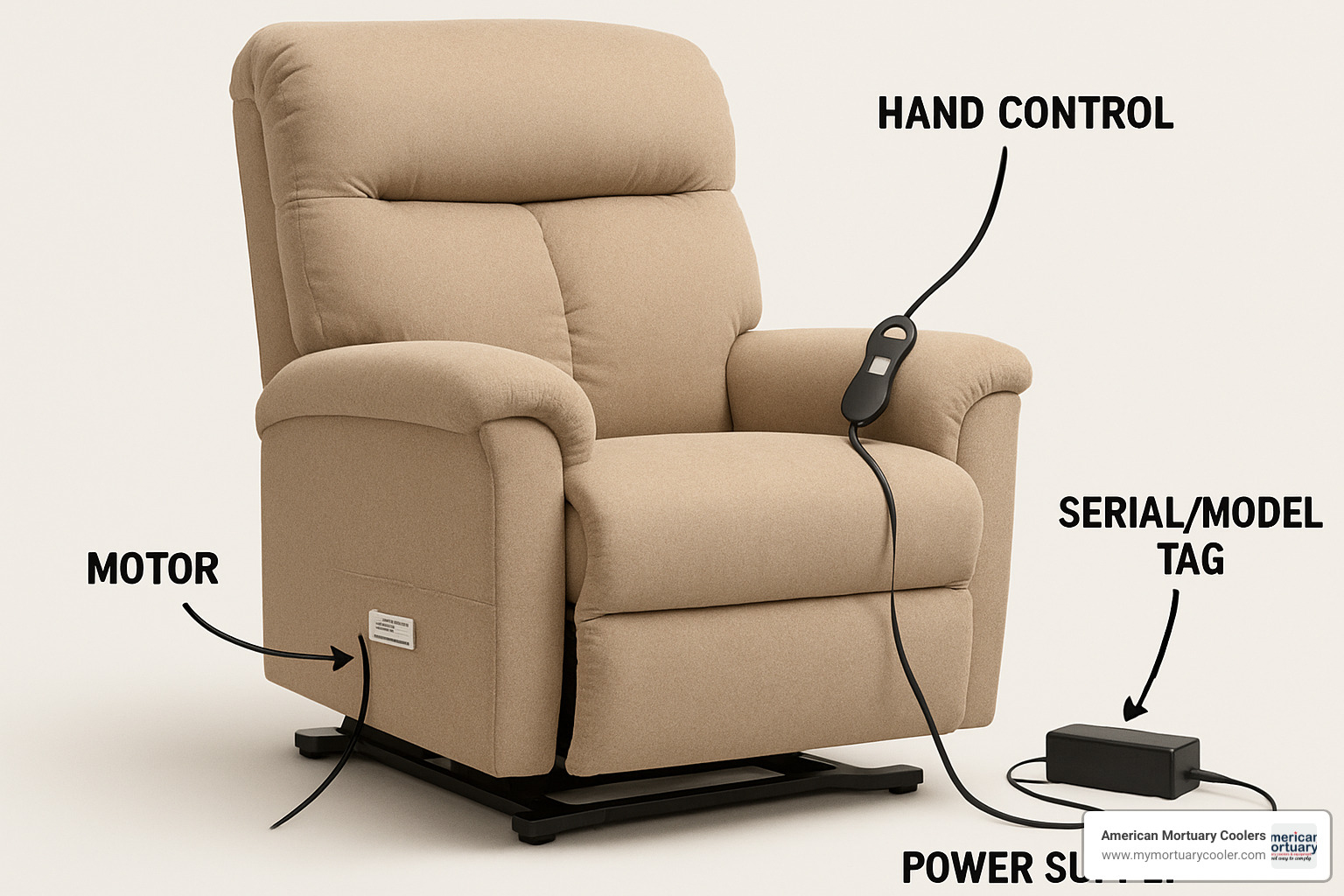
Chair Lift Parts Lookup Tools
You don't have to figure this out alone – there are several helpful resources that make identifying parts much easier.
Many manufacturers offer online parts diagrams with exploded views that show how everything fits together. Bruno, for example, has an interactive catalog that lets you zoom in on specific areas of your lift model. These diagrams are like roadmaps that lead you straight to the part number you need.
Cross-reference databases are particularly useful when the exact OEM part is hard to find. These tools, often maintained by specialized suppliers, help match generic parts to specific models – a real lifesaver for older lifts.
Don't underestimate the value of good technical support. Many suppliers have knowledgeable staff who can identify parts based on your description or photos. As one customer shared: "Our elevator repair company couldn't find a replacement board. We emailed a photo to Access2Parts and they identified it immediately." Sometimes a quick conversation saves hours of frustration.
Newer lift models are making identification even easier with QR codes and smart labels that link directly to relevant parts information. Just scan the code with your smartphone and you're taken straight to the right page – no searching required.
Step-by-Step Ordering Checklist
To make sure you get the right part the first time (and avoid the headache of returns), follow this simple process:
Start by checking your warranty status. If your lift is still covered, contact the manufacturer first – unauthorized repairs might void your remaining coverage. Some warranties cover parts but not labor, so it's worth knowing exactly what's included.
Gather all the documentation you'll need: photos of the failed part from multiple angles, any visible part numbers, and your lift's model and serial number. Having this information ready will make the ordering process much smoother.
Next, decide where you'll buy the part. Will you go with OEM, aftermarket, or refurbished? Consider your budget, how quickly you need the part, and whether maintaining warranty coverage matters to you. Always select a reputable supplier with good reviews – this isn't the time to gamble on an unknown vendor.
Before placing your order, verify compatibility. Confirm the part works with your specific model, check voltage requirements for electrical components, and verify physical dimensions for mechanical parts. This extra step can save you from the disappointment of receiving a part that doesn't fit.
When you're ready to order, provide all required information clearly, consider expedited shipping if the part is urgently needed, and save your order confirmation and tracking information. One satisfied customer told Stairlift-parts.com: "I received an email with a link within 2 minutes of my parts request. This is the best service I have ever had."
Finally, prepare for installation by deciding whether you'll tackle it yourself or hire a professional. If you're going the DIY route, gather necessary tools and safety equipment, and review installation procedures before the part arrives. For more information about safe handling of lift equipment, check out our guide on safe handling practices with mortuary lift equipment.
At American Mortuary Coolers, we understand that keeping your equipment running smoothly is essential, whether it's in a funeral home or a private residence. Our team is always ready to help you identify the chair lift parts you need to keep your mobility equipment in perfect working order.
DIY vs Professional Repair: Tools, Skills & Costs
So you've got your replacement chair lift parts in hand – now comes the big decision: Should you roll up your sleeves and install them yourself, or call in a professional? This isn't just about saving money; it's about safety, confidence, and knowing your own limits.
When You Can Fix It Yourself
Let's be honest – some chair lift repairs are actually quite manageable, even if you're not particularly handy.
Swapping out batteries is usually straightforward – disconnect the old, connect the new, and you're back in business. You'll typically just need a screwdriver and about 15 minutes of your time. The satisfaction of saving $75-150 on a service call makes it even sweeter.
Replacing a hand control or remote is another DIY-friendly task. Most are designed to be plug-and-play, though some might need simple programming following the included instructions. The best part? Even if you make a mistake, you won't compromise the lift's safety systems.
Seat cushions and covers fall firmly in the cosmetic repair category. With a few fasteners removed, you can refresh your lift's appearance without any risk to its mechanical operation. This simple update can save you $75-125 in unnecessary service fees.
Basic maintenance tasks like cleaning and lubricating the track, tightening loose fasteners, or making minor seat adjustments are perfect for homeowners. With your owner's manual in hand and some basic tools, these routine jobs can keep your lift running smoothly while saving $75-200 per service call.
For these simpler tasks, your toolbox should include:
- Basic hand tools (screwdrivers, wrenches, pliers)
- A digital multimeter for testing electrical components
- Your manufacturer's maintenance guide
- Appropriate cleaning supplies and lubricants
When to Call a Certified Technician
Some repairs, however, venture into "professionals only" territory – and for good reason.
Motor or gearbox replacement isn't just complex; it's safety-critical. These components require precise alignment and adjustment, often with specialized tools. An improper installation could lead to dangerous malfunctions. This isn't the place to learn by trial and error.
When it comes to control board replacement, you're dealing with the brain of your lift system. These often require specific programming, calibration, or diagnostic software that's only available to certified technicians. One wrong connection could affect multiple safety systems.
Any repairs involving tracks or rails should give you immediate pause. These structural components bear the full weight of both the lift and its passenger. Improper installation could lead to catastrophic failure – something no amount of savings is worth risking. These jobs often require specialized tools and precise measurements, not to mention potential building code considerations.
Safety system repairs – including components like overspeed governors, limit switches, and obstacle detection systems – should always be handled by professionals. These systems are your last line of defense against accidents, and they require precise adjustment and thorough testing to ensure proper function.
Professional service typically costs:
- Service call fee: $75-150
- Hourly labor rate: $75-150 per hour
- Typical repair time: 1-3 hours depending on complexity
- Total professional repair cost: $150-600 plus parts
A specialized Stairlift Installation Tool Kit costs around $159.77 according to Access2Parts – a clear indication of the specialized equipment professionals use for proper installation.
"Many technicians worldwide provide 24-hour stairlift service to alleviate hindrance for the aged and infirm. Proper parts and installation are crucial for safety and reliability." — Stairlift-parts.com
At American Mortuary Coolers, we understand the importance of balancing cost savings with safety. While we encourage our customers to handle simple maintenance tasks, we also recognize when expertise matters. After all, whether in our custom mortuary equipment or your home mobility solutions, reliability isn't just about convenience – it's about dignity and safety for those who depend on these systems.
Maintenance Tips to Reduce Part Replacement
Let's face it – nobody wants to replace chair lift parts more often than necessary. With some simple, regular TLC, you can dramatically extend your lift's lifespan and keep repair costs to a minimum. Think of it as preventive medicine for your mobility equipment!
Weekly Maintenance
Your weekly maintenance routine doesn't need to be time-consuming. Just spend a few minutes doing a quick visual inspection of your lift. Look for any loose fasteners, frayed cables, or worn upholstery. These small issues can become big problems if ignored.
While you're at it, grab a clean, dry cloth and wipe down the rail. You'd be surprised how much dust, hair, and everyday debris can accumulate and affect smooth operation. This simple habit prevents unnecessary wear on rollers and drive components.
Before finishing your weekly check, take a test ride! Run the lift through its full travel path, listening for any unusual noises and feeling for vibrations or jerky movements. Catching these early warning signs can save you from more expensive chair lift parts replacements down the road.
Monthly Maintenance
Once a month, show your chair lift some extra love with proper lubrication. Apply the manufacturer-recommended lubricant to the track and any swivel seat mechanisms – but remember, motors and electrical components should stay dry! Over-lubrication can be just as harmful as no lubrication at all.
Your lift's batteries deserve monthly attention too. Use a multimeter to check battery voltage and make sure charging contacts are clean and corrosion-free. A well-maintained battery can last years longer than a neglected one.
While you've got your tools out, take a moment to check all fasteners. Tighten any loose screws or bolts, especially on mounting brackets and track attachments. The vibration from regular use can gradually loosen these critical connections.
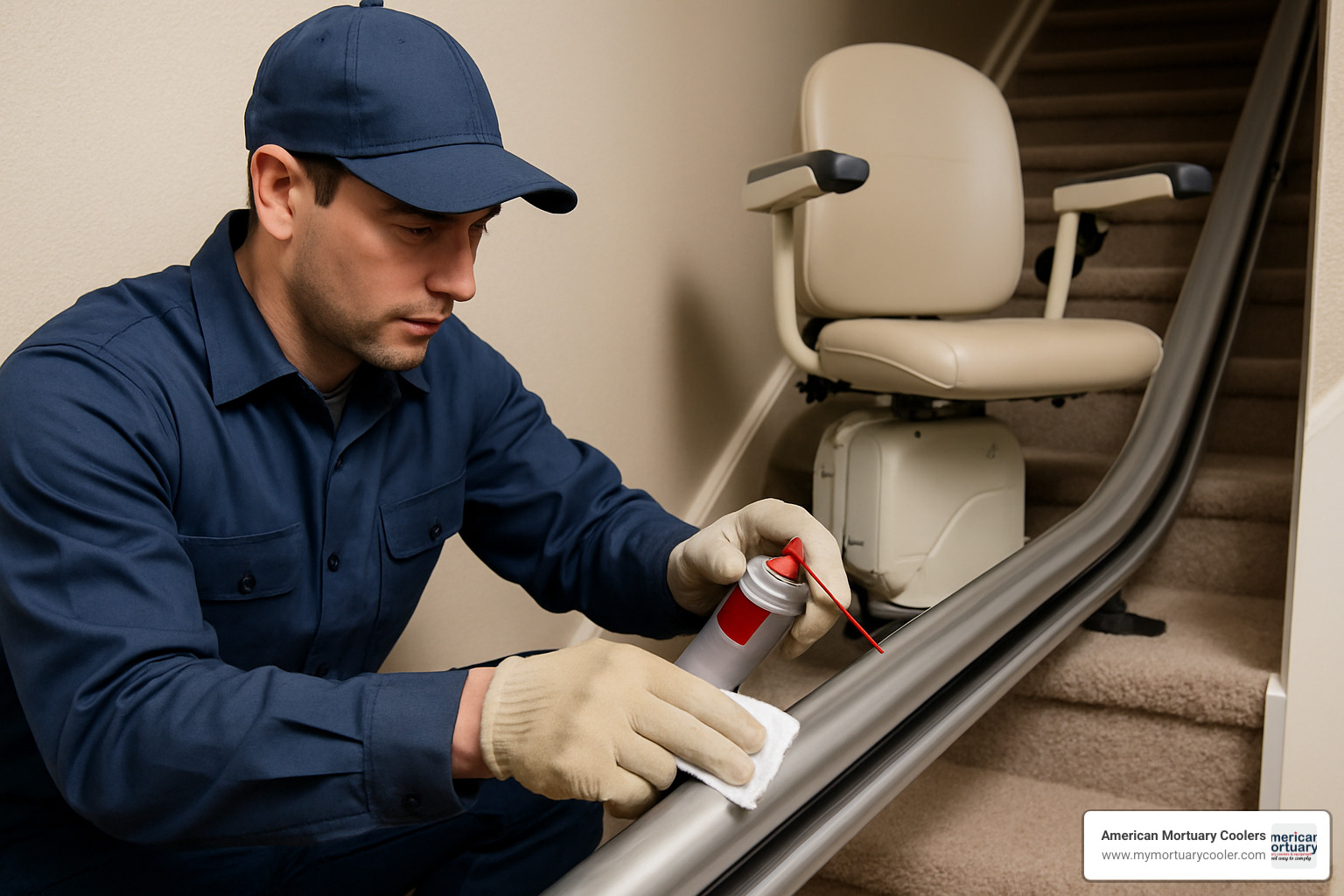
Quarterly Maintenance
Every three months, set aside time for a more thorough cleaning. Use appropriate cleaners on all exposed surfaces, vacuum dust from motors and gear assemblies, and clean battery terminals and electrical connections. A clean lift is a happy lift!
This is also the perfect time to put those safety systems through their paces. Test all safety switches, sensors, and obstacle detection features. Make sure your emergency stop button works flawlessly – this is one feature you hope to never need, but must always work perfectly.
Take a moment to assess overall performance too. Is the travel speed consistent? Does the lift start and stop smoothly? These subtle changes in performance often signal that chair lift parts are beginning to wear before they fail completely.
Annual Professional Service
Even if you're diligent with DIY maintenance, there's no substitute for an annual visit from a certified technician. These professionals have the training and tools to spot issues you might miss and can provide documentation important for warranty and insurance purposes.
During this yearly checkup, your technician might recommend replacing certain wear items before they fail. This might seem unnecessary if the parts are still working, but preventive replacement is nearly always less expensive and disruptive than emergency service calls after a breakdown.
"Most of our emergency service calls could have been prevented with regular maintenance," shares one of our service partners. "It's much easier to replace a battery during a scheduled visit than when someone is stranded upstairs."

At American Mortuary Coolers, we understand the importance of keeping all your equipment running smoothly – whether it's our mortuary coolers or your facility's mobility equipment. We've seen how proper maintenance can double or even triple the lifespan of mechanical systems.
Remember what the maintenance experts at LiftChairExperts say: "We pride ourselves in providing only the best quality electronic and non-electric Lift Chair Replacement Parts. Proper maintenance with quality chair lift parts ensures years of trouble-free operation."
By following these simple maintenance guidelines, you'll not only save money on replacements but also ensure the safety and reliability of your lift for years to come. And isn't that peace of mind worth a few minutes of maintenance each week?
Frequently Asked Questions about Chair Lift Parts
Do I need OEM parts to keep my warranty?
Wondering about those warranty implications? You're not alone. When it comes to chair lift parts, the warranty question is one of our most common inquiries.
In most cases, manufacturers require OEM parts to maintain your warranty coverage. Think of it like your car - using aftermarket parts might save money, but could void that manufacturer protection. However, every situation has nuances:
If your lift is already dancing beyond its warranty period, you've got complete freedom to choose any compatible parts that fit your budget and needs. Some manufacturers are more flexible than others, occasionally honoring warranties if replacement parts meet their quality standards. And if you purchased an extended warranty through a third party? Their policies might differ entirely from the original manufacturer's rules.
"I was worried about using a non-OEM battery, but my warranty had expired two years ago. The aftermarket option saved me nearly $70 and works perfectly," shared one of our customers in Georgia.
The bottom line? If your lift is still under warranty, a quick phone call to the manufacturer before ordering non-OEM parts could save you headaches down the road.
How long does shipping usually take?
When your mobility depends on a functioning lift, shipping timelines matter tremendously. Most specialized chair lift parts suppliers understand this urgency.
The good news is that many reputable suppliers process orders lightning-fast - typically within 8 business hours of receiving your order. For standard deliveries within the continental US, you can generally expect your parts to arrive within 3-7 business days. Need it faster? Expedited shipping options can cut that down to just 1-3 days for those truly urgent situations.
International customers should plan for longer timelines, typically 1-3 weeks, as customs processing can introduce unpredictable delays.
As Stairlift-parts.com promises their customers: "Orders are picked and shipped within 8 business hours, with parcels shipped via Track & Trace worldwide." Most quality suppliers provide tracking information so you can monitor your shipment's journey right to your doorstep.
What if my lift model is discontinued?
The dreaded "discontinued" status doesn't mean you're out of options. Even when manufacturers stop producing certain lift models, finding chair lift parts remains possible through several channels.
Most reputable manufacturers maintain parts inventories for discontinued models for 5-10 years after production ends. They understand the longevity of these investments and won't leave customers stranded. In some cases, they might offer alternative parts that can be adapted to work with your system.
Specialized parts warehouses like Access2Parts have built entire business models around supporting discontinued equipment. They often acquire inventory when manufacturers exit markets or update product lines.
For truly older models, refurbished options salvaged from decommissioned lifts provide another path. These parts are typically thoroughly tested and refurbished before resale.
As one relieved Access2Parts customer shared: "Our elevator repair company couldn't find a replacement board for a year—this site had it in stock and shipped fast."
In the most challenging cases, adaptation solutions exist where newer parts can be modified to work with older systems, though this typically requires professional technical expertise.
Can I install any brand of batteries in my chair lift?
Battery replacement seems straightforward, but there's more to consider than just finding something that fits in the compartment. While batteries may look similar, important differences affect both performance and safety.
The voltage must match exactly – typically 12V or 24V for most chair lifts. Using a battery with incorrect voltage can damage your lift's electrical system or create safety hazards. The capacity (measured in Amp-hours) should meet or exceed the original specifications to ensure proper runtime.
Physical considerations matter too – terminal type and orientation must be compatible, and the dimensions must fit in the existing battery compartment without modifications.
We've seen customers try to save a few dollars with generic batteries, only to face costly repairs when those batteries damaged their control systems. When in doubt, consult with a professional or contact us directly – the small premium for the right battery is worth the peace of mind.
How do I know if a part is genuinely compatible with my lift?
Compatibility questions keep many lift owners awake at night. With so many models and variations, determining true compatibility requires checking several key factors.
The most reliable indicator is an explicit listing – the part is specifically mentioned as compatible with your exact make and model, and ideally, the supplier confirms compatibility based on your serial number. At American Mortuary Coolers, we always recommend providing your complete model information when ordering chair lift parts.
Beyond listings, physical dimensions matter tremendously. The part should have identical mounting points and dimensions, with connectors and interfaces that match exactly. For electrical components, matching voltage, current, and power ratings is essential for both functionality and safety.
Modern lift systems introduce another layer of complexity: software compatibility. For electronic components, firmware version compatibility can be crucial, as newer parts may not work properly with older control systems.
The safest approach is always to provide your lift's complete information – make, model, and serial number – to your supplier and explicitly confirm compatibility before finalizing your order. A few extra minutes confirming details can save days of frustration and additional shipping costs.
Conclusion & Next Steps
The journey of maintaining your mobility equipment doesn't end with a single repair—it's an ongoing commitment to safety and independence. Finding the right chair lift parts when you need them is more than a technical challenge; it's about preserving the freedom and dignity that mobility solutions provide.
Throughout this guide, we've explored everything from basic maintenance to complex repairs, always keeping in mind that behind every chair lift is a person who depends on its reliable operation.
At American Mortuary Coolers, we understand this deeply. While our name might suggest we focus exclusively on mortuary equipment, our expertise extends to all aspects of specialized equipment maintenance—including the vital mobility solutions that many of our customers rely on daily.
When your lift needs attention, remember these essential points:
Prevent before you repair. The most cost-effective approach is always preventive maintenance. A simple weekly wipe-down and monthly check can save thousands in emergency repairs and extend your lift's life by years.
Document everything. Keep your model numbers, serial tags, and maintenance records organized. When you need a part quickly, this information will be your best friend—saving both time and frustration.
Choose wisely between DIY and professional help. Some tasks, like battery replacement, are perfect for the handy homeowner. Others, like motor replacement or safety system repairs, demand professional expertise. Know the difference—your safety depends on it.
Quality matters in chair lift parts. Whether you choose OEM, aftermarket, or refurbished components, never compromise on quality. The small price difference between a bargain part and a reliable one disappears quickly when faced with repeated failures.
Build a relationship with a trusted supplier. Finding a reliable source for chair lift parts isn't just about today's repair—it's about having a partner for your equipment's entire lifecycle.
From our home base in Tennessee to funeral homes across Georgia, Illinois, and all 48 contiguous states, we've built our reputation on understanding specialized equipment needs. We know that whether it's a mortuary cooler or a chair lift, equipment failures don't just inconvenience you—they can completely disrupt your life or business.
That's why we're committed to being more than just a parts supplier. We're your partner in maintaining the equipment you depend on, with the expertise to guide you through challenges and the inventory to solve them quickly.
For more information about durable lift solutions that stand the test of time, visit our detailed guide at More details on durable lift solutions. And remember, behind every part number and technical specification, there's a simple truth: mobility equipment isn't just about movement—it's about independence, dignity, and quality of life.
We're here to help you preserve all three.


















